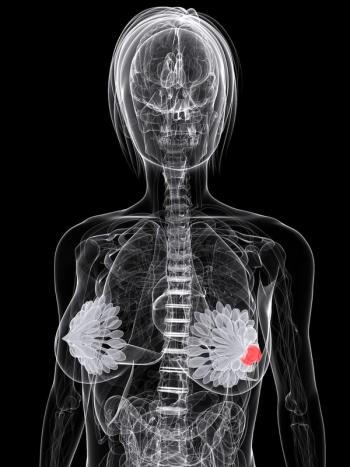
H.R. 2541: Examining Its Legislative Impact on Radiopharmaceutical Practice
The Nuclear Medicine Clarification Act seeks to increase transparency in reporting potentially high-dose extravasations in administering radiation.
A bipartisan bill was referred to the House Committee on Energy and Commerce earlier this year that to date has 8 cosponsors.1 The bill, H.R. 2541, or the Nuclear Medicine Clarification Act of 2025, seeks “to require Nuclear Regulatory Commission [NRC] to revise its regulations to protect patients from unintended exposure to radiation during nuclear medicine procedures, and for other purposes,” as stated in its official title as introduced.
Specifically, this bill would aim to change how extravasations, or medication leaking from the vein to surrounding soft tissue, resulting from nuclear medicine procedures would be reported, requiring medical providers to report large incidents of extravasation, or medical events, to the NRC. The bill suggests revisions for extravasations exceeding a 5 cm3 of tissue or 0.5 Sv shallow dose equivalent to the contiguous 10 cm2 of skin receiving the highest absorbed dose during residence time.
Currently, providers are not required to report extravasations to the NRC as medical events, with the NRC citing a “significant licensee and regulatory burden with no additional benefit to patient safety.”2 Additionally, they posit that no clinical evidence exists which suggests that patients are being harmed from excess radiation dose or compromised diagnostic studies due to radiopharmaceutical extravasation.
To better elucidate the circumstances surrounding the introduction of this legislation, CancerNetwork® spoke with Jackson W. Kiser, a diagnostic radiologist and chief of Molecular Imaging at Carilion Roanoke Memorial Hospital in Roanoke, Virginia, and Thomas Hope, MD, vice chair of Clinical Operations and Strategy and professor in the Department of Radiology at the University of California, San Francisco (UCSF), regarding their perspectives surrounding the legislative proposal.
Extravasations Might be Dangerous but Avoidable
When asked about the issue the bill is seeking to address, Kiser suggested that radioactive materials present in radiopharmaceuticals may leak outside a patient’s vein and enter local tissue during injection, resulting in an extravasation. Furthermore, he explained that in addition to compromising the diagnostic quality of the imaging during radioactive dosing, extravasations could potentially leak high doses of radiation to the local tissue, causing concerns such as skin necrosis.
“What [the bill is] hoping to address is the fact that in 1980, the NRC stated that these extravasations occur in about 10% to 15% of patients to some degree [and] that these are unavoidable–there is nothing you can do to stop them–which is entirely false,” Kiser expressed. “[There are many] ways you can mitigate these [events], but what the congressmen who presented this bill are looking to do [is have] it to require reporting of these high-dose extravasations.”
Additionally, he remarked that, despite individuals who may deny the presence of extravasated material outside of a patient’s injected tissue, extravasated material can be removed from the field of view during imaging and go unreported. He added that a lobby of individuals is seeking to prevent these incidents from happening by requiring that they are reported as medical events.
A spokesperson for one such patient advocate group, Patients for Safer Nuclear Medicine (PSNM), Mary Ajango, director of Advocacy for Young Survival Coalition, advocated for a greater degree of transparency in requiring the reporting of extravasation to the NRC.
“If radiation is inadvertently spilled onto a patient, that incident must be reported to NRC–yet if it is accidentally injected into a patient’s tissue, no report is required. This policy makes zero sense and opens the door to lasting patient harm,” she expressed in a written article on the bill.3
Additionally, Kiser cited previous work he conducted, which he claims contradicts the assertion that extravasation is unavoidable, a claim the NRC made in 1980 when it amended medical use regulations to require medical misadministration.4 The agency excluded extravasation as a misadministration on the grounds that it occurs in otherwise normal intravenous or intra-arterial injections, as well as the purported claim Kiser disputed.
The quality improvement study Kiser conducted attempted to assess the impact of a quality improvement plan with the Lucerno Lara System, which uses sensors to detect radiation beneath a patient’s skin, on extravasation rates.5 The system itself is installed on a patient’s arm using atraumatic pads, with 1 sensor capturing activity from the radiotracer and the second one acts as control. According to the developers, the sensors provide a real-time display of administration quality, and, after the uptake period, the recorded data can be uploaded to an application where a time-activity curve is displayed “within seconds.”
Investigators reported a reduction in extravasation rate from 13.3% (n = 35) among 263 injections without the quality improvement plan, to 2.9% (n = 8) across 278 injections with the plan, a 78% reduction (P < .0001). Additionally, among 8 technologists with prior experience with the technology, the extravasation rate was 1.2%.
“You can modify this, and you can do better; that is a ‘MythBuster’ about the 1980s statements,” Kiser concluded.
Additionally, regarding the use of the system, he suggested that it could be easily integrated into a radiologist’s workflow, explaining that device installation could take as little as 10 seconds.
“There’s always a learning curve once you start something like this, but once you get a flow and get the muscle memory down, [it should be] easy because we do it on all our patients whenever possible,” he stated.
Ascertaining the Potential Impact of the Bill on Nuclear Medicine
In responding to a question regarding the aim of H.R. 2541, Hope was uncertain what clinical problem the bill was attempting to fix.
“Although there are infiltrations in nuclear medicine, is there a high incidence of associated adverse events (AEs) ––patients having injuries to their arm because of infiltrations in radiopharmaceuticals? I would probably argue, no,” Hope explained. “The goal of the bill is to increase reporting requirements, but I am not sure what it is trying to address. Is there a clinical problem that we need to fix that is going to be addressed through these increased reporting requirements?”
He further asserted that the impacts on clinical practice were equally as opaque but inferred that it might result in a more cumbersome patient workflow, potentially adding visits and increasing post-injection monitoring among all patients treated with radioactive materials, regardless of observed infiltration. Hope also suggested that infiltrated material is reabsorbed and does not remain in the arm permanently, which diminishes the risk of prolonged tissue damage with these agents.
Additionally, Hope explained that at his institution, UCSF, despite performing over 10,000 PET scans and administering nearly 1000 therapeutic doses a year, he stated not having observed a single case of infiltration-related AE. “Although extravasations are not uncommon in nuclear medicine, clinically relevant complications are vanishingly rare. Although they have been reported, complications are limited to radiopharmaceuticals rarely used in clinical practice. No complications have been reported with treatments used in patients with prostate cancer and neuroendocrine tumors, such as peptide receptor radionuclide therapy and PSMA-targeted radioligand therapy.”
“With clinically significant infiltrations for CT scans, we do a physical exam, check on it, and that happens all the time,” he described. “With radiopharmaceuticals the volumes are much less compared to a CT scan, where you are administering, say, 100 mL to 150 mL. For a radiopharmaceutical, we are typically administering between 10 mLs and 30 mLs. If you are going to take cold syrup, that little cap that you take cold syrup in is about the same volume. That type of volume is not enough to physically injure the tissue.”
Furthermore, Hope raised questions about how the impact of modified regulations related to electronic health records (EHR) would impact workflows for documentation and data entry and retrieval. Specifically, when reporting radioactivity left in the arm, including measurements of the volume of infiltrated material, documentation flows may be delayed by a factor of days. Additionally, he highlighted a concern that integrating the proposed changes from H.R. 2541 may present access challenges in a field already in need of an increasing availability of sites for patients to access imaging agents. The proposed changes would require measurement of radiopharmaceuticals that would require medical physicists involvement.
“In terms of the workflow in the clinic… the biggest issue in radiopharmaceutical imaging and therapies is access. Do we have enough sites that can do these types of therapies out there?” Hope expressed. “This would be another significant barrier to increasing the availability of sites and locations for patients to have access to these therapies and imaging agents.”
Highlighting Disparate Perspectives on the Passage of H.R. 2541
In clinical practice, Kiser believes that leaked radioactive material is a prevalent and potentially dangerous occurrence. Regarding the legislation, he asserts that it may be beneficial for patients who are seeking transparency following treatment with radiopharmaceuticals, as well as circumventing potentially serious AEs.
“[H.R. 2541], depending upon how it reads, could be [quite] impactful. It’s good for patient care. It’s good for safety, image quality, and all these other things because you want that dose to go where it’s supposed to go, not into the [healthy] tissue at the injection site,” he concluded. “It’s going to be interesting to see how this plays out, what happens with it, and how Congress will debate it and send it up to Senate. It’s going to be interesting to see how it goes, but I hope they do the right thing.”
However, Hope suggests that the bill may not be effective in helping to enhance patient-centric care, and that greater reporting in the rate of radiopharmaceutical leakage may not correlate with a clinically relevant improvement in outcomes.
“There are no clinical adverse events that we are trying to prevent. If you were to implement a bill to try to fix something, you measure how often that thing occurs, and then you minimize it. We should be measuring an improvement in some sort of patient-centric outcome. We are not going to be able to measure ‘that’ because there is no ‘that.’ ‘That’ does not actually exist,” he concluded.
References
- H.R.2541 - Nuclear Medicine Clarification Act of 2025, 119th Cong (2025). Updated April 1, 2025. Accessed October 17, 2025. https://tinyurl.com/33n97vjr
- US Nuclear Regulatory Commission. NRC staff preliminary evaluation of radiopharmaceutical extravasation and medical event reporting, final report. September 16, 2021. Accessed October 17, 2025. https://tinyurl.com/mcyxa4d5
- Murphy H. Bill that would require providers report extravasations of radioactive drugs is back on the House floor. April 3, 2025. Accessed October 17, 2025. https://tinyurl.com/3x57zjdt
- Kiser JW. Quality improvement using new technology to assess and reduce FDG PET/CT radiotracer infiltrations. J Clin Oncol. 2018;18(suppl 30):313. doi:10.1200/JCO.2018.36.30_suppl.313
- The Lucerno Solution for extravasations. Lucerno Dyamics. Accessed October 17, 2025. https://tinyurl.com/39cjbtvx
Newsletter
Stay up to date on recent advances in the multidisciplinary approach to cancer.

















































































